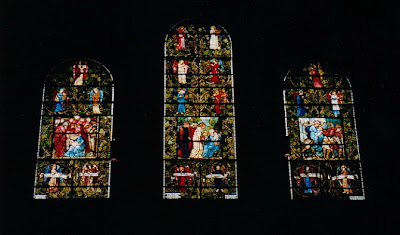
Manufacturer William Morris
Designer Edward Burne-Jones
The Nativity
Ponsonby Church, Ponsonby, Cumbria, England
 Manufacturer William Morris
Manufacturer William MorrisDesigner Edward Burne-Jones
The Nativity [detail]
Ponsonby Church, Ponsonby, Cumbria, England
 Manufacturer William Morris
Manufacturer William MorrisDesigner Edward Burne-Jones
The Nativity [detail]
Ponsonby Church, Ponsonby, Cumbria, England
 Manufacturer William Morris
Manufacturer William MorrisDesigner Edward Burne-Jones
Adoration of the Magi
Trinity Church, Saugerties, New York
 Manufacturer William Morris
Manufacturer William MorrisDesigner Edward Burne-Jones
The Nativity
Trinity Church, Saugerties, New York

Manufacturer William Morris
Designer Edward Burne-Jones
Nativity windows,
Trinity Church, Boston

Manufacturer William Morris
Designer Edward Burne-Jones
Nativity windows, [detail]
Trinity Church, Boston
William Morris (March 24, 1834 – October 3, 1896) was an English artist, writer, and socialist.
He was one of the principal founders of the British Arts and Crafts movement, a pioneer of the socialist movement in Britain, and a writer of poetry and fiction.
He is perhaps best known as a designer of wallpaper and patterned fabrics
Morris was part of a group of friends and collaborators, Dante Gabriel Rossetti, Edward Burne-Jones, Ford Madox Brown and Philip Webb. These friends formed an artistic movement, the Pre-Raphaelite Brotherhood.
In 1861, he founded the firm of Morris, Marshall, Faulkner & Co. with Gabriel Rossetti, Burne-Jones, Ford Madox Brown and Philip Webb. In 1874 Rossetti and Ford Madox Brown decided to leave the firm, requiring a return on their shares which proved to be a costly business. Throughout his life, he continued to work in his own firm, although the firm changed names. Its most famous incarnation was as Morris and Company. The company encouraged the revival of traditional crafts such as stained glass painting.
Sir Edward Coley Burne-Jones, 1st Baronet (28 August 1833–17 June 1898) was largely responsible for bringing the Pre-Raphaelites into the mainstream of the British art world, while at the same time executing some of the most exquisite and beautiful artwork of the time.
After leaving Oxford, from which he did not take a degree, he became closely involved in the rejuvenation of the tradition of stained glass art in England
He had intended to become a church minister, but under Morris's influence decided to become an artist and designer instead.

No comments:
Post a Comment